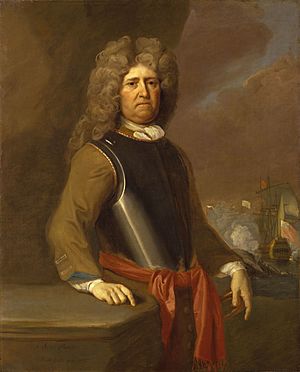John Munden facts for kids
Quick facts for kids
Sir John Munden
|
|
|---|---|

Portrait of Sir John Munden, painted by Michael Dahl in 1705
|
|
| Born | c. 1645 |
| Died | 13 March 1719 Chelsea, London |
| Allegiance | |
| Service/ |
|
| Rank | Rear Admiral |
| Commands held | Edgar Coronation Lenox St Michael Monmouth Albemarle London Ranelagh Winchester |
| Battles/wars | Battle of Beachy Head Battle of Barfleur |
| Relations | Sir Richard Munden (brother) |
Sir John Munden (born around 1645 – died 13 March 1719) was an important officer in the Royal Navy. He became a Rear Admiral. Later, he was removed from his job after a mission where he didn't fight a French fleet. Even though a special navy court said he did nothing wrong, he was still dismissed.
Contents
John Munden was born in Chelsea, London, around 1645. His father, Richard Munden, was a ferryman. John was the younger son in his family.
He began his naval career on 30 November 1677. He was made a second lieutenant on the ship St David. He sailed in the Mediterranean until 1680. During this time, he served under his older brother, Sir Richard Munden.
Afterward, he moved to other ships. These included the Constant Warwick in 1681 and the Mary Rose in 1685. He also served on the Charles Galley in 1686. In July 1688, he became the commander of a special ship called the Half Moon, which was a fire ship.
Becoming a Captain
John Munden became a full captain on 14 December 1688. Lord Dartmouth gave him command of the ship Edgar.
He took part in the Battle of Beachy Head in 1690. There, he commanded the Coronation. Two years later, on 19 May 1692, he fought in the Battle of Barfleur. He was in charge of the Lenox. His ship was at the front of the red squadron, following orders from Sir Ralph Delaval.
Over the next few years, he commanded several other ships. These included the St Michael in 1693 and the Monmouth in 1695. He also commanded the Albemarle in 1696 and the London in 1697.
In May 1699, he was given command of the Ranelagh. Just two months later, he moved to the Winchester. He was then sent to the Mediterranean leading a small group of ships. While there, he helped create a treaty with the ruler of Algiers. This treaty helped control ship movements. He also managed to get English people who were enslaved released. He returned to England in November 1700.
Rising to Admiral
His work in the Mediterranean impressed King William III. This led to his promotion on 14 April 1701. He became a Rear Admiral of the blue squadron.
Just a few months later, on 30 June, he was promoted again. He became Rear Admiral of the white squadron. He was given the important job of escorting the king to Holland. The very next day, the king honored him by making him a knight. This happened on the royal yacht William and Mary.
A Challenging Mission
In April 1702, during the reign of Queen Anne, news arrived. The French planned to send ships from Corunna to the West Indies and Mexico. These ships were carrying important people and soldiers.
Sir John Munden, now Rear Admiral of the red squadron, was chosen to stop them. He had a group of eight large warships and four smaller ones. Munden sailed from St. Helens on 10 May 1702. Five days later, he reached the coast of Galicia.
He soon learned that thirteen French warships were coming from La Rochelle. On 28 May, he saw them near Cape Ortegal. He chased them, but they managed to get into Corunna harbor before he could catch them. Munden held a meeting with his officers. They decided the harbor was too well protected to attack.
After cruising the area until their supplies ran low, the British fleet went home on 20 June. The mission had not gone as planned. They only managed to capture two merchant ships from Martinique.
Dismissal from Service
The failure of this mission caused a lot of public anger. On 13 July, Sir John Munden faced a special navy court, called a court-martial. This happened aboard the ship Queen at Spithead. He was accused of not doing his job properly.
In his defense, he explained how difficult it was to find ships at sea. He said, "It is easy for anyone watching to say, after a plan fails, that if you had been here instead of there, you would have succeeded." He added that they missed the enemy by only a short time.
The court-martial, led by Sir Cloudesley Shovel, agreed with Munden. He was found not guilty of all charges. He even returned to his command on HMS Victory (1695) on 21 July.
However, many people were still upset. Someone needed to be held responsible. Sir John Munden was chosen, even though the court had cleared him. On 10 August 1702, he was officially removed from his position in the Royal Navy. This was a very unusual and strict decision. It was explained that even a small mistake should be punished early in a new queen's rule. This was to show that the new queen was strong and fair.
After this, Sir John Munden retired to Chelsea. He was known as a simple man in how he talked and dressed. He passed away there on 13 March 1719. He was not married and had no children. His property was divided among his three nephews and five nieces.

